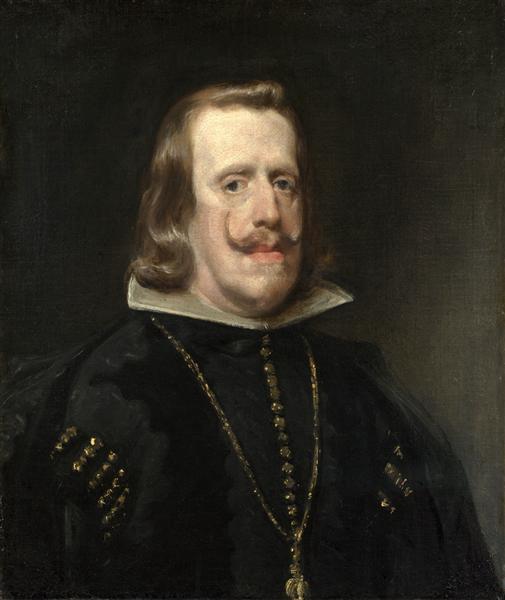Description
The painting "Portrait of Philip IV of Spain", painted by Diego Velázquez in 1656, is one of the most notable depictions of the Spanish monarch, an outstanding example of the artistic style of the Spanish Golden Age and, in particular, of the masterful technique of the Sevillian painter. Velázquez, known for his ability to capture light and exquisite detail, uses a carefully selected color palette in this work that reflects the serious and majestic character of the king, while revealing the intimacy of the portrait.
King Philip IV, depicted against an imposing dark background, stands out with his rich and elaborate clothing. The artist mainly uses dark shades of brown and black that contrast with the golden touches of his attire, presenting a conjunction of elegance and royal power. Among the elements that adorn the monarch's clothing is the cord of the Order of Charles III, which not only indicates his status, but also adds a sense of solemnity to the figure. The choice of an almost austere staging, without too many decorations, allows the attention to focus on the figure of the king, who looks with an expression of confidence and serenity.
The composition of the painting is characterised by its simplicity in the background and the formality of the king's posture, which is based on a rigid structure that reinforces his authority. The use of light, which falls on the face and details of Philip IV's clothing, is a hallmark of the tenebrist style that Velázquez employs in this period of his career, alluding to his mastery in the creation of volumes and textures. This chiaroscuro technique creates a three-dimensional effect that brings life to an image that in other contexts might have seemed static.
It is worth noting that Philip IV was a great lover of the arts and a prominent patron of Velázquez, which makes this work stand out not only as a physical representation of the king, but also as a testimony to the relationship between the monarch and his painter. The painting is not filled with secondary elements or characters as would be observed in other works by Velázquez, which underlines the artist's intention to present the king in a context that evokes both power and closeness. This reflects a change in royal portraiture, which tended to be more rigid and formal, towards a more humanized and accessible representation.
It is essential to mention that this portrait, like other masterpieces by Velázquez such as "Las Meninas", contributes to a psychological complexity in the representation of the portrayed. The king's gaze, which seems to direct his attention both to the spectator and to a distant point, invites reflection on the role of the monarch in a world full of intrigues and challenges. This play of glances establishes an implicit dialogue that transcends the simple act of contemplation, offering a vision of the duality of power: the loneliness that often accompanies those who wield it.
In short, the "Portrait of Philip IV of Spain" is a work that not only fascinates for its technical virtues and psychological depth, but also represents a crucial moment in Velázquez's career and in the history of Spanish art. Through this painting, the viewer can glimpse not only the representation of a king, but also a meditation on the power, solitude and glory that royalty brings. The work continues to be a point of reference in the study of Baroque painting and the evolution of royal portraiture, consolidating Velázquez as one of the great masters who has left an indelible mark on the history of art.
KUADROS ©, a famous painting on your wall.
Hand-made oil painting reproductions, with the quality of professional artists and the distinctive seal of KUADROS ©.
Painting reproduction service with satisfaction guarantee. If you are not completely satisfied with the replica of your painting, we will refund 100% of your money.

